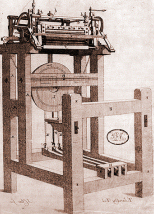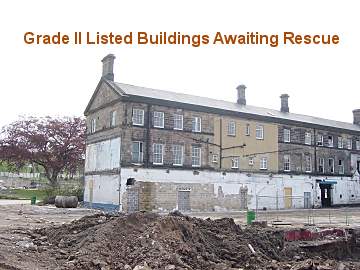
George Brettle and Company Limited, were a hosiery firm based in Belper, Derbyshire and Wood Street, City of London. They were hosiery manufacturers in Belper from 1799-1984.
But the firm of Ward Sharp and Company (established in 1801) had its origins in the hosiery business conducted at Belper, Derbyshire by the Ward family.
It was formed by John Ward and James Sharp who also opened a warehouse in London where they could sell their products produced at Belper. Following financial problems, William Ward invited George Brettle (1778-1835) to join the partnership in 1803 and the firm was renamed Ward Brettle and Ward.
Prosperity soon returned and by the end of the decade, the firm was employing 1,000 people. Its wholesale warehouse accommodation became insufficient and new premises were taken in Wood Street, City of London to supply London's drapers with cloth, hosiery, haberdashery and blankets. By the 1830s, it was one of the biggest hosiery firms in the country.
 THE WARD FACTORY IN BELPER
THE WARD FACTORY IN BELPER

The death of William Ward in 1833 left the firm in the hands of Brettle alone and he named the firm, 'George Brettle and Co.' The Ward family, excluded from the business but still in possession of the premises at Belper, set up the firm of Ward Strutt and Sharp.
George Brettle purchased a site nearby for his own warehouse in Belper. It is now the home of "De Bradelei Mill" a discount outlet.

DE BRADELEI MILL
Ward, Brettle & Ward
The firm of Ward Sharp and Company (established in 1801) had its origins in the hosiery business conducted at Belper by the Ward family. It was formed by John Ward who had followed his hosier father into the industry in the 1780s and James Sharp who also opened a warehouse in London where they could sell their products produced at Belper.
Following financial problems, William Ward invited George Brettle (1778-1835) to join the partnership in 1803 and the firm was renamed Ward Brettle and Ward.
Prosperity soon returned and by the end
of the decade, the firm was employing 1,000 people. Its wholesale
warehouse accommodation became insufficient and new premises were taken
in Wood Street, City of London to supply London's drapers with cloth,
hosiery, haberdashery and blankets. By the 1830s, it was one of the
biggest hosiery firms in the country.
The death of William Ward
in 1833 left the firm in the hands of Brettle alone and he named the
firm, 'George Brettle and Co.'
The Ward family, excluded from the business but still in possession of the premises at Belper, set up the firm of Ward Strutt and Sharp. George Brettle purchased a site nearby for his own warehouse in Belper.
Brettle died in 1835, leaving the
running of the firm to three friends until his three sons were of age to
succeed to their partnerships from 1843. By 1872 all three sons were
dead and, although steam power and mechanisation of production had been
introduced, the firm had lost its dominant position to Wards of Belper.
Problems with labour supply and the workforce, growing competition from
the German hosiery industry, and costly family settlements restricted
the growth of Brettles over the next thirty years.
Brettles growth declined in the general austerity following
the war. In 1974, the firm was
bought outright by Courtaulds and became Courtaulds Hosiery Limited. By
the 1970s, the factory at Belper produced only knitted stockings and
tights. In 1997, Chilprufe bought Brettles from the Courtaulds Group and
moved production to Leicester. Production returned to Belper in 2002
when Brettles was sold to lingerie manufacturer, Slenderella by
Chilprufe's receivers.
Framework Knitting in Crich, near Belper.
A Summary - by Mrs. D. M. Howarth

Royal Oak Cottages, one of a small row of cottages on the Common in Crich, is one of the best remaining examples of a stockinger's or framework knitters house. Here in 1851 lived Benjamin and Ellen Walker with their five children aged 5 - 16 years. There must have been many houses with families like this living in Crich at this time.
The continuous rows of windows on the top floor of the house is the external sign that framework knitting was carried on inside. Behind these windows there would be a packed row of frames on which the framework knitters would work making cotton stockings.
In 1844 there were 245 frames in Crich, a large number for a rural village. This indicates that there must have been many houses like this one, which still stands on Crich Common today. The knitting frames were originally invented by the Rev. William Lee of Calverton, Nottingham in 1589 and improved by Jedidiah Strutt in 1758.
They have been described as the most complex machines in industrial use before the 18th century. They consisted of 3,500 different components which took 50 days to make and 12 days to assemble and so were very expensive. They were rented to the framework knitters who not only had to repair and maintain them in working order, but sometimes had to adapt them to produce different kinds of work.
The framework knitters rented their frames from hosiers. The practice of charging the workers seems to have been a safeguard to make sure of a return on the considerable capital invested in the frames. It is likely that in Crich most were rented from hosiers in nearby Belper.
In 1829 the largest hosiers in Belper were Messrs. Ward, Brettle & Ward, who rented out about 400 silk stocking frames and 2,500 cotton hose frames to stockingers in the town and outlying villages. Their factory in Belper was built in 1835 and at about that time 100,000 dozen pairs (1,200.000 pairs) of stockings were produced annually..
In Crich during the middle of the 19th century there were 127 families, with 270 people involved in framework knitting, making cotton stockings. Many of these families lived in concentrated groups in various parts of the Parish, particularly around Crich Common and Fritchley, so that it is likely that the family living in Royal Oak Cottages, mentioned at the beginning of this article, would be very typical one of that time.






